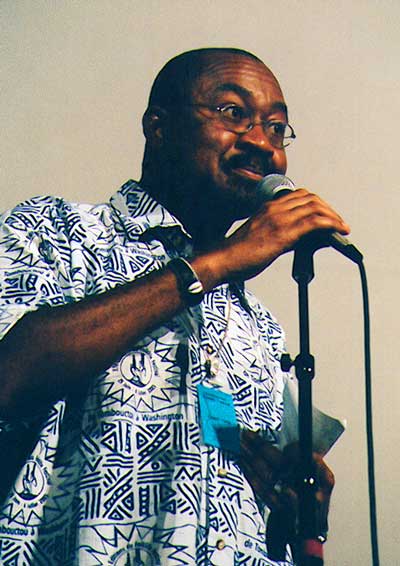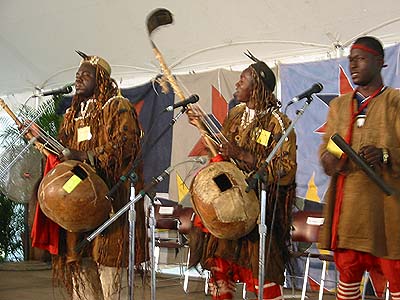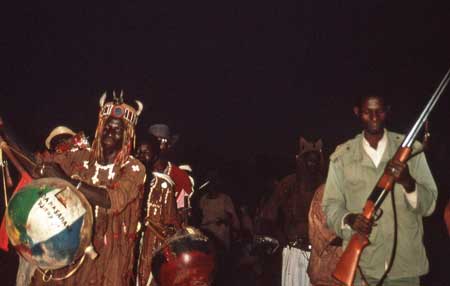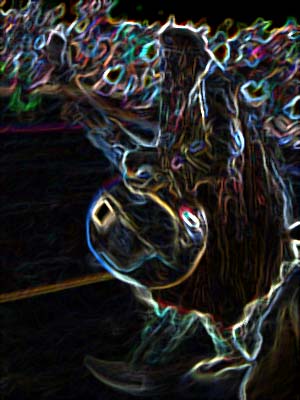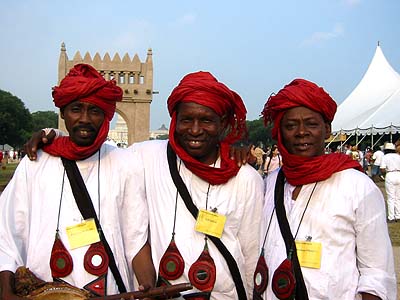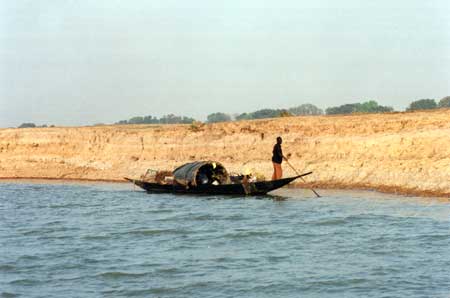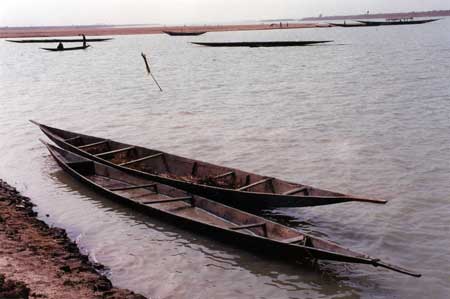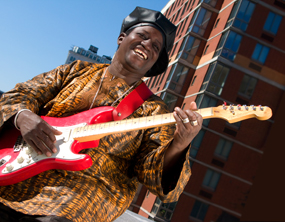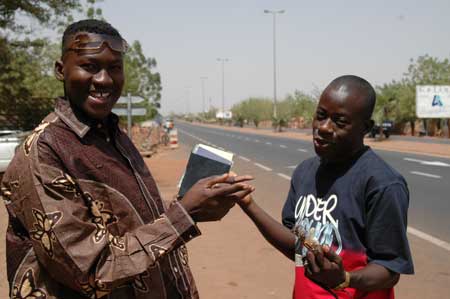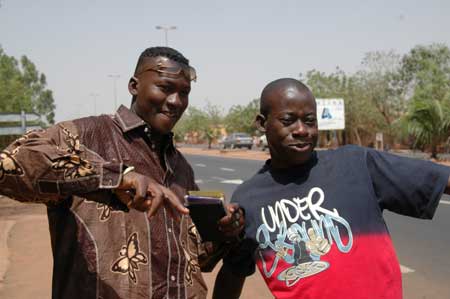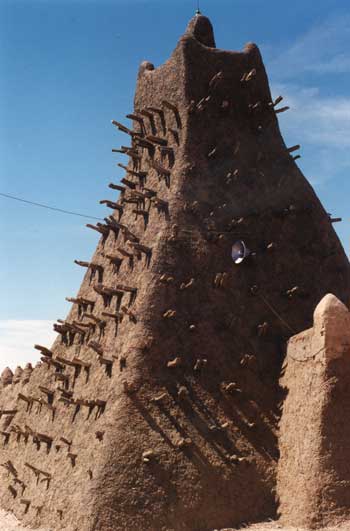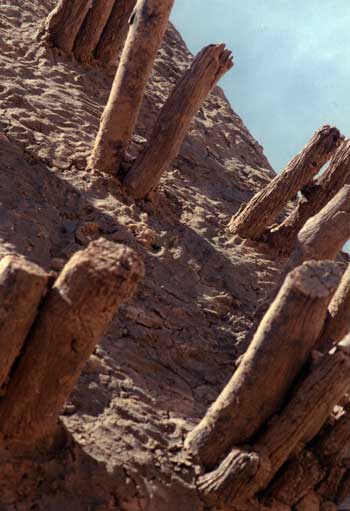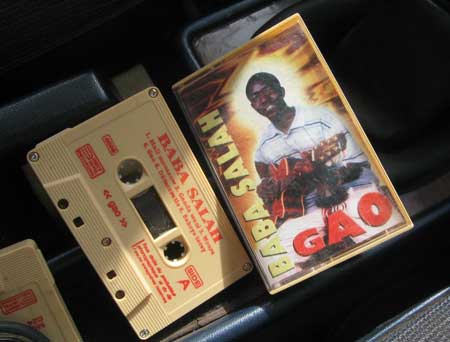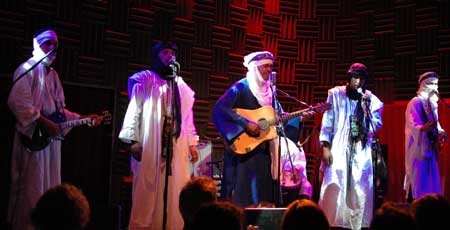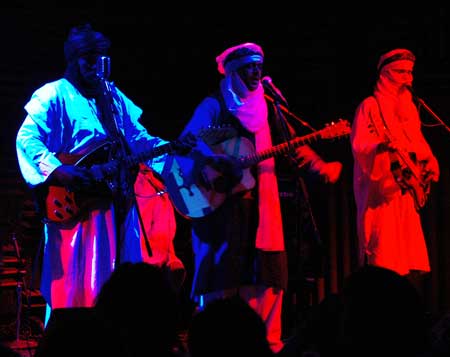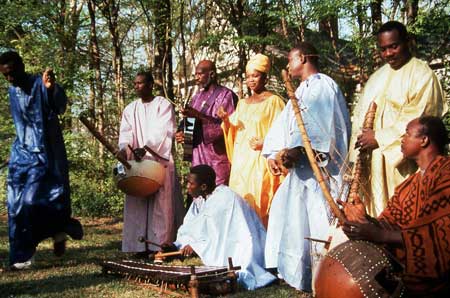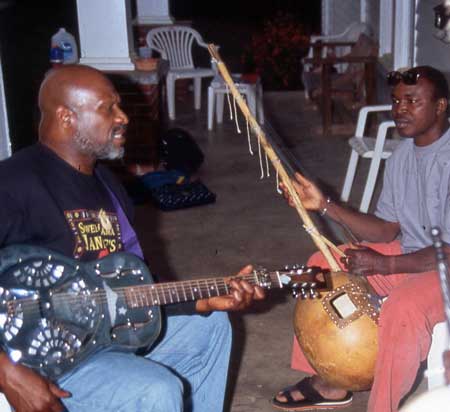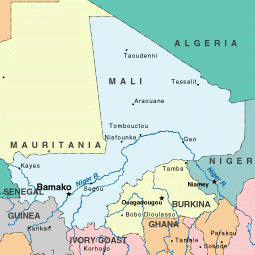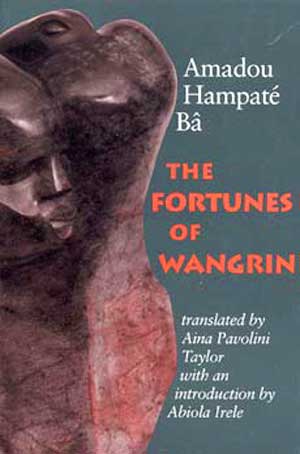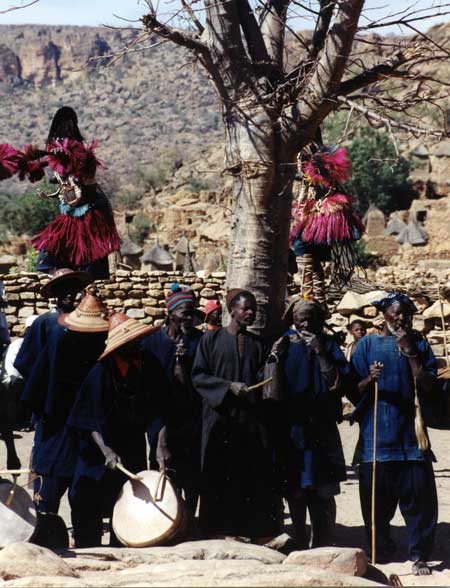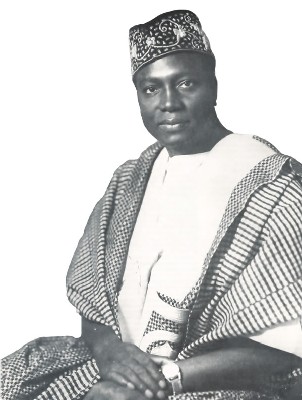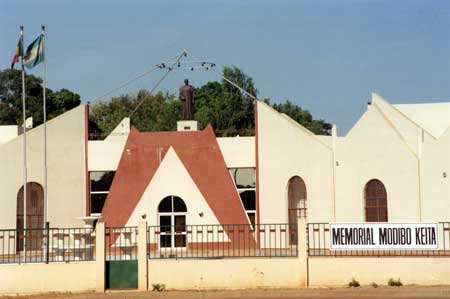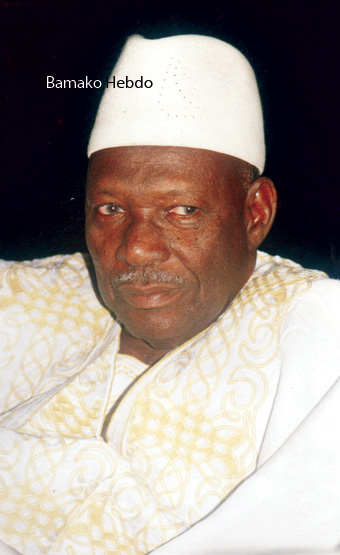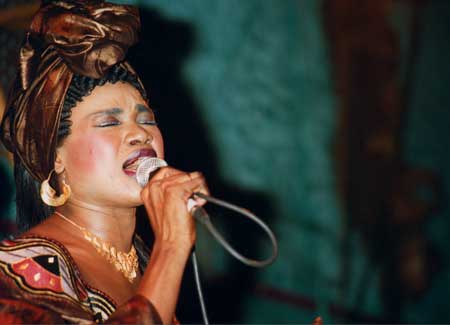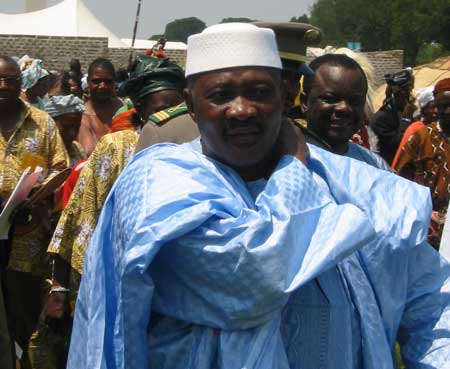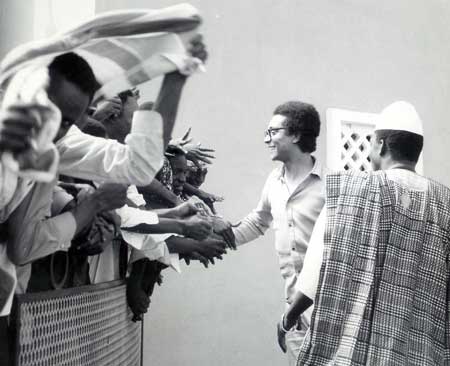Cherif Keita is Professor of French and Francophone Literatures at Carleton College in Northfield, Minnesota. He is also an expert on the cultural history of his native Mali. He will soon publish the English version of his book on Mali’s greatest popular singer, Salif Keita. Every other year, Cherif takes a group of lucky students to Mali for three months of cultural discovery, using music, literature, architecture, and history to understand the country’s extraordinary story and nature. Cherif is the main voice in Afropop Worldwide’s Hip Deep program, Mali: Ancient Empires to Multi-Cultural Democracy. Here is the complete transcript of Banning Eyre’s interview for that program.
Banning Eyre: Cherif, let’s go back as far as we can in history. What do we know about the oldest human life there?
Cherif Keita: At the origin, everything started with the hunters. In many societies, you know, hunters were the military force, to protect society against forces of invasion. As such, they had to be organized in a military fashion, to be trained to endure the toughest conditions, to travel over long distances, and certainly to hunt. But also, if the military campaign required that they venture very far away from the borders of the village, then they would do so. All that required physical discipline, physical resilience. And added to that is the moral code of conduct that went with hunting.
You have to understand first that hunting is the process of mediation between invisible and visible forces. The invisible forces are the djinns, the spirits that tend to inhabit the bush. And the visible forces are the forces at home, in the world of the known—that is, the predictable social relations that any person growing up within a culture would learn to master. But the mastery of the invisible is something that is achieved through a long process of training, of moral cleansing of oneself. For instance, they say that hunting is incompatible with lying, not being truthful, adultery, or cheating people.
An encounter with the invisible can be very dangerous if the person doesn't have the moral purity required for such encounters. So you can see the social element, but also the spiritual element of hunting. There is a code, a system to train the individual from a very young age through the stature of a master, a person who controls the animals—the most dangerous ones. The hunter is able to also bring back from this unknown world of danger something that would benefit society, something that can be humanized and harnessed to feed society, and to treat social or physical illnesses—basically help society grow.
B.E.: Tell us a little more about these invisible forces.
C.K.: Well, one element that is crucial when one deals with the Mande world is the notion of the nyama. Nyama can be best understood as a vital force that exists in everything. One can make a comparison with Native American traditions here in the US. Native Americans believe that there is a soul in everything in life. So also we in the Mande world—and also in many African traditions—have the same belief that in every living animal or inanimate thing, there is this a vital force which needs to be handled very carefully for fear that it could harm the person who is manipulating it. For instance, certain types of trees are known to have a very strong nyama. For that reason, it is very rare for people to cut them down, because of the nyama. And probably, if one wants to use rationalistic terms, one may say that maybe these trees are useful to the life of human beings because they sustain it in particular ways. So there is this vital force, this nyama, and if you cut that kind of tree, you have to be prepared to handle that.
The same thing goes for hunting. They say that it is very easy to kill an animal, but it is not easy to control the nyama of it. In fact, this is one of the formulas that you find in hunters’ songs. You can kill the big snake, but it is not easy to control the nyama of the big snake. Hunting is a process whereby people learn to control the nyama of whatever creature they happen to kill, either out of necessity, or by accident. When hunters kill certain types of animals, they have to be purified by special rituals before they are readmitted into the village. Otherwise, if they come into the village, they will be followed by the nyama of that animal, which can eventually harm society.
B.E.: Cherif, “nyama” is a Mande word and a Mande concept, and it comes in later when we get to the griots and other hereditary trades. But we are talking about a much older time here, right? A time before there was such a thing as Mande.
C.K.: Well, before organized states, you see? This goes back to prehistory really.
B.E.: So nyama is an ancient idea.
C.K.: It is a very ancient idea. That's right. A very ancient idea, this belief in the nyama. But as I say, it is at the center of the Mande spirituality.
B.E.: Okay. We will come to that. But let’s talk about how music figures in this world of the hunter.
C.K.: The hunter was probably the first musician in that culture. The first musician. Because the hunter would use his instrument... I say “his” because in the world of hunting, it’s the man who goes out and can take the life of animals. Women give life, but they don't take it. So the men go out and hunt animals, and they would be really the first heroes, whether it's in their interaction with animals or in the fight in the battlefield. At the same time, they are the ones that would use their own instrument, which was the simbi, although it is the donsongoni in the Wassoulou area. The simbi is the first form of that instrument. Maybe the oldest. Before the simbi, there were other instruments, such as the bolon, which has three strings. The simbi has seven strings and it comes from the area called Mande, which is a circumscribed area between Mali and Guinea.
the hunters would take this instrument and literally sing their own praises. They would retell their feats against animals and also animal spirits. There are spirits, djinns, that change themselves into animals to fight against the hunter, and this can lead to great, epic battles. Hunters would retell these exploits accompanying themselves with the simbi. So there, we have the conjunction of two personalities: the heroic personality or the man of action, and the artistic personality, in particular the artist of the word. Both were conflated in the same person, the hunter-bard. He would both hold the gun and also the simbi, the musical instrument. This really takes us back to the beginning.
Many of the songs they created recall the name of a brave hunter who is seen as a model in posterity, and retell that person's particular feats in the field. That would describe most of the repertoire, and that had a profound impact in the evolution of music in the Mande world in later periods. Because that's where many of the songs and the rhythms were taken from: from hunters songs.
B.E.: Can you give an example?
C.K.: One of those songs is called "Janjon." This is really a heroic song. It celebrates people who have shown bravery in the field of hunting or on the battlefield. In fact, it is said that in the past, if that song was played, whoever was allowed to stand had to be somebody recognized as a brave person, as a hero. So everybody sat, and only the people who have been recognized, or who are being celebrated, would stand and walk around or take a few dance steps. So “Janjon” was a very important hunters song, and you have several different kinds of versions of it. Certainly the jali [griot] version came out of that. In fact, I heard a version of "Janjon” at a hunters gathering that is very close to the one found in the jali repertoire in areas such as the Gambia, the Senegambia. I believe the song “Jula Jekere” is taken directly from "Janjon."
B.E.: So these songs come in families, don’t they? One grows out of another, and others grow out of it. And you can trace the oldest ones all the way back to the hunters.
C.K.: Exactly. That's right. If one looks at the history of the jali, or griot, as we see it in the Mali Empire, they say that the Kouyates were the first jali clan, the authentic jali clan. You know, in most of the family names in Mali, you find an horon or noble branch and a jali branch. But the Kouyate can only be jali. Why are the Kouyates only jalis? Because they were the jali of the Keita; Keita, again going back to Sunjata Keita, or Sunjata's family. They were the ones who were present to educate the Imperial family, and to become really the accomplices of the Keita family. In fact the name Kouyate means “kon y’an te.” “Kon y’an te” in Malinke or Bambara means "there is a secret between us." That's where the name Kouyate comes from. So this makes the Kouyate clan the first griot clan, the authentic griot clan, and the griots to the Keita, with whom they share this secret, they share this complicity, which is “kon y’an te.”
B.E.: Okay, before we go on with Sunjata and the griots, I want to talk a little about how the hunters are viewed in Malian culture today.
C.K.: Hunters have always been around. They have never gone away. In fact, the image of the hunter is one of the most enduring symbols of Mande identity. Let me tell you how the Mande people consider, envision their identity. They use the image of a boat that will pitch from side to side, but will never capsize. They say, Manden be lonbo lanban, nka Manden te dafiri, which means "Mande is a boat that will pitch, but will never capsize.” That means that the Mande people have always envisioned their identity as something that defies time by a constant process of both holding onto tradition, but also accepting changes to it, always taking stock of what is inherited from the past, but always transforming it in the light of new experiences in society.
So this image of the boat that pitches but always maintains itself afloat is very important. And we see that image reflected in Sunjata Keita himself. It is part of the way Mande people see Sunjata. They say, "Sunjata is the person who has scattered Mande, causing it to spread by shaking its foundations, but who has also been able to adjust Mande on its foundation."
There is a paradox here. A person who shatters the status quo by literally scattering the people, by taking them far away from their place of origin through conquest, through travel, through exchange, but by doing so, he also opened the Mande world to taking in new things. You see what I mean? He also prepared this culture to absorb, to assimilate. So this is the image that the Mande people always associate with Sunjata. He who has scattered Mande, but has also adjusted Mande on its foundation. This is the paradox.
As I told you, the hunter is the mediator between the known world, the home or village, which is called so in Mande, and the unknown world, the forest, which is called wula. The hunter goes back and forth between these worlds. In fact the name “donso” means “he who returns home.” He can go out, but he will always return safely home, and he will always bring something good for the people. But the other side of it is that the hunter is always the one who is sent first to experiment with what is outside, what is not known by the others. And hunters, as such, have discovered villages. They have discovered places that were propitious for human habitation. They will negotiate with the spirits that live in that area, then come back and tell the people, "We should settle this area because it has everything we need to support our lives."
So, you see, the hunters were really explorers. And in the field of music, the role of the hunters in the origin of musical instruments can never be overestimated. In practically every story of the origin of an instrument, there is a hunter who goes out and kind of wrestles an instrument that used to be used by the djinns, and then learns how to play it and then brings it inside the village.
B.E.: Oh, that’s interesting. Can you give an example?
C.K.: Well, take an instrument like the balafon. The balafon is an example that can function in two different ways. Initially, people say it was the hunter during one of his outings who saw the djinns playing it. The hunter became so mesmerized by that he decided then to enter into a transaction with the spirits, and get the instruments from them and bring it home. The same thing with the simbi. The simbi also was an instrument that used to belong to djinns, until the hunter brought it into the village.
Talking about the balafon, the griots explain it in a slightly different way. But again, it goes back to the spirit world. In the Sunjata story, as the Kouyate people start with Balla Faseke Kouyate, that eponymous, central griot, who was Sunjata's griot. He was taken captive by Soumaoro Kante, the sorcerer King of Soso. He came and invaded Mande and chased the princes out, killed them, and sent people into exile. So when Balla Faseke was taken hostage by Soumaoro, he discovered this instrument in Soumaoro’s magical room or workshop. Soumaoro, as the sorcerer King, and also a hunter, used the balafon to praise himself. So this goes back to the image of the hunter as the hero/artist, both personas conjoined in a person. And it took the action of Balla Faseke, who entered the anti-chamber, this magic space, and took that instrument and brought it into the social space, the collective space. From there it eventually becomes an instrument that a class of people used to sing the praises of other individuals.
B.E.: Okay, so Malians understand these connections. But still, I’m curious about how contemporary Malians view hunters.
C.K.: Well, hunters never went away. They've always been around. And they still symbolize this very important part of Mande heroic personality, which is the mediation between the old and the new. And this applies not just to instruments but also musical genres. The hunter in his outings may encounter certain ways of playing music, or certain musical forms that come out of these encounters, and bring those in. So again, we see the hunter as a modernizer, as well as a protector of tradition. It's very paradoxical, but this is at the heart of the Mande worldview, and that's very important.
So this is why it was very natural that Alpha Oumar Konare recognized the hunters as president in 2001. Alpha Oumar Konare was the first democratically elected president of Mali after the transition of 1991 and ’92. He was the president, but also a historian and an archaeologist. He felt that there was no better time within the context of democratic Mali to recognize the role of the hunter as the protector of Malian society, but also as someone whose teaching still carries some pertinence to modern-day realities. So he decided to organize this first, big, West African meeting of traditional hunters. I would say they were probably 40,000 to 50,000 hunters that came from Senegal, the Gambia, Guinea, Burkina Faso, Niger. And the Ivory Coast, although no official delegation came from the Ivory Coast because of the political situation, and the role that the hunters had played on the modern political scene there. So Côte d'Ivoire did not send any official delegation of hunters, but the hunters themselves crossed the border from the Wassoulou area on foot and came to be part of this great meeting of traditional hunters.
For one week, this was something to see. I mean the whole of Bamako was taken over by these formidable looking people with their amulets hanging from the red colored shirts and pants, with little mirrors, and with their instruments hanging from their sides, walking in procession everywhere in Bamako. The festival happened not only in Bamako. Part of it happened in Segu and in the Wassoulou. It was just amazing, and I think Alpha Oumar Konare was making a statement about the role of the hunters, not only for present-day Mali, but for future Mali. The educational baggage that they bring with them, the values that they bring with them, are something that modern Africa still needs, and it was a way for him to say that.
Of course, in every political act, people will see the good and the bad. Some people said that Alpha was trying to bring the un-Islamic elements, or the occult world, to kind of buttress or legitimize his own power. But I don't think much of that was true.
B.E.: That was the Islamist critique?
C.K.: That's right. The Islamist critique. Exactly! And also, this critique was not new. It had been put forth before when Alpha was putting monuments in different parts of the city of Bamako, because Bamako was really a city without monuments. At the time of independence, during the time of the nationalistic movement, many of the statues, which used to be colonial statues, were destroyed. Bamako was literally left without any place markers that would not only beautify it, but also make it easy for people to identify places. So one of the great things that Alpha did as a historian was to start putting these symbols in very visible places. One of those statues, in fact, is located right in front of Oumou Sangare’s hotel in Bamako, not too far from the airport. It is the statue of a buffalo, which goes back to Sunjata's mother as the Buffalo woman. Sogolon Konte was a buffalo. At least her double was a buffalo. Again, by putting that statue there, I think that Alfa was paying tribute to the woman as a holder of knowledge, but also as a source of strength, baraka. In fact, it is believed that in a person's life, your strength, your baraka, comes from your mother. So, again, the relationship in epic stories between the hero and his mother, or his sister, because the female figure is always the source of baraka. So that was one of the statues, the statue of the buffalo. People call it Sogolon’s statue.
B.E.: And Oumou herself is of course a modern symbol of that strength.
C.K.: That's right. Oumou, being that new strength, that female strength in Malian musical creativity. I don't know. Oumou’s hotel probably came later, so I don't know whether Oumou saw that as a good place to put her hotel, and a place to identify with. But certainly it is at the most perfect location.
B.E.: Sure is. And I remember lots of other interesting monuments around the city when I last visited there.
C.K.: Yes. So people said that Alpha as he was erecting statues in different parts of Bamako, people were saying that he was starting to promote idol worship. You see what I mean? Those statues were viewed by certain segments of society as being un-Islamic.
B.E.: Let's talk about the coming of Islam to Mali.
C.K.: Well, the coming of Islam I think was not so much a process of conquest, military conquest. I think that part of the western Sudan—Sudan meaning "the country of the blacks," in Arabic—was a zone of exchange, an area of trade. Islam came mostly through trade during the Empire of Ghana—I would say during the 10th century, 11th century. From that time on in urban areas, Muslim traders would set up shop and then begin to interact with people and teach this new faith. The Mande people are a very mobile people, and I think that's probably one of the assets that Islam came with. Most of the traditional religions related to specific locations. They were religions of the village whereas Islam is a very portable religion, so it was a perfect fit for the temperament of this cultural milieu. As people traded and moved around from one area to another, Islam became a very convenient kind of spiritual ideology to take with them.
I think the griot can also be seen within that worldview. The griots often attribute the origin of their trade or craft to Bilali the muezzin of the Prophet. The muezzin is the person who calls the faithful to the mosque to gather and pray. So Bilali as a black person—Bilali was apparently a slave of African origin—was probably one of the first converts to Islam, and was one of the closest companions to the Prophet. So what he does, calling people to prayer and being always next to the Prophet, already mirrors the relationship that the jali has as an artist with his or her patron. By using the image of Bilali, the jali can easily project themselves into the Islamic mold, although they probably pretty existed before Islam. They were there before Islam, but with the coming of Islam as a new ideology in the 9th, 10th, 11th centuries, the griots, the oral artists, had to find a way of legitimizing their function, and going back to Bilali, the faithful companion of the Prophet, helps them establish that image of the patron and the artist.
B.E.: I’ve heard this story told a number of times. It is clearly a strong point of pride with griots to this day.
C.K.: I want to say something about the etymology of the word “jali.” You hear different ways of pronouncing it. Some people say “djeli,” some people say “jali”. Yes, both terms are Malinke terms used to describe the oral artists. But I believe that the authentic word is jali. Why? Because one has to be able to find etymologically a link between the patron and the artist. The reason why I call them jali, and they call themselves jali, is that the patron of the artist is the jatigi. The jatigi is the patron. Now the etymological link between the two words is the word jigiyya, which means “hope.” So at the origin, the jali was jigiyyali, “the person who brings his hope to a patron,” the person who comes literally and entrusts himself to a patron. He comes with his jigiyya, his hope. Now, why is the patron called jatigi? It is because, originally they used to call him jigiyya-tigi. Tigi means “the holder,” the owner of the jigiyya, the hope of somebody else. So there you can see that the direct connection is jigiyya tigi and jigiyyali. Jigiyya tigi became jatigui, and jigiyyali became jali... the patron and the artist.
So the word “djeli,” which oral artists usually like to use, conjures the symbolism of blood. They say, “We are djeli. We are like the blood of the human body." The body... no being can live without blood.
B.E.: So “djeli” means blood?
C.K.: Djeli means blood. That's right. They like to use the symbolism of blood, of djeli, to say that the oral artist, the praise singer, is as important to society as the blood is to the body. So they like to create poetry on the word djeli. It's just a metaphor. But the true word for this group of artists is jali.
B.E.: Oh, that's a very interesting. I always thought it was a difference of regional dialect, or French vs. English. I didn't realize that the two words had different meaning. But let's come back to some history. Tell us a little bit about the empires themselves, the empire of Mali, and those that came before and after.
C.K.: The Mali Empire came around the 13th century, right after the Ghana Empire. The empire of Ghana was between the 9th century and maybe the 12th century, and it was located more or less between Mali and Mauritania. Remember, those areas used to be very green in the past. In fact, they were a very important historic and economic center between North Africa and sub-Saharan Africa, as we call it today. The empire of Ghana was based on gold. The mainstay of Ghana was gold. Bu then there was a process of desertification; the desert has been expanding for a long time.
It is believed that the empire of Ghana came as a result of a young man—I've forgotten his name. But this young man’s fiancée was to be sacrificed to the great snake which was the protector of the Ouagadou Empire, the Ouagadou bida. So it is said that the young man whose fiancée was going to be killed decided instead to kill the snake, and from that time, a big drought lasted for many, many decades, and started to make the area of the empire of Ghana not favorable for human habitation, so people started to migrate. So already we have this notion of diaspora coming from the empire of Ghana.
So, the Mali Empire, which was really a small kingdom at the end of the 12th century, was the place where the movement of unification of small kingdoms started, under Sunjata. We know that the Soso Kingdom with Soumaoro Kante came as an invading force into Mande, into Mali, which was at that time a very small state formation. Sunjata came back from exile to liberate Mali, but once he succeeded in doing that, he decided to unify the small scattered kingdoms that were victims of slavery and intergroup hostility. He decided to unify them, and I think that's where the empire building process started. So part of it was military, yes, fighting the invading forces, but also pushing outwards as fast and as far as they could, and at the same time unifying people using cultural traits to establish customs and social norms.
B.E.: Can you give an example of that?
C.K.: Well, one of the great legacies of the Mali Empire is the joking relationship between clans, sanankouya, which allows members of certain clans, to have great freedom in their speech with each other, and with other clans. For instance, a Keita would have as a joking cousin anybody from the Coulibaly clan, or the Toure, or Cisse, or Samake clans. These would be our joking cousins. So once we see each other, we will start mocking each other. We start disparaging each other: "You are my slave. Your people cannot be trusted because you are thieves." But it's all really in fun. Joking cousins are not supposed to get mad at each other. Because the belief is that your joking cousin is a little bit of yourself. You cannot be mad at yourself. So in fact, the joking relationship, the trade of derogatory terms, is a way of countering the nyama of social relationships. The tension that exists within different kinds of social relationships is being countered by this freedom in speech, which we call sanankouya.
B.E.: I’ve seen this. In fact, I remember being taken aback by it when I lived in Mali. Then Djelimady Tounkara explained to me that this custom is one of the reasons that different ethnic groups get along so well together in Mali today.
C.K.: That is true. Exactly! Because you see, the joking relationship can be translated between groups that today may not look very similar. Take, for instance, the relationship between the Mande people and the Wolof people. We don't speak the same language. Maybe linguists can go back and trace some very old links. But today, Bambara or Malinke and Wolof don't sound the same at all. But, if one goes back to the tradition of sanankouya, the joking relationship, one finds that Mande names are translatable clearly into Wolof names. A person who is Traore in Mali, or in the Mande world, when that person goes to the Gambia, or to Senegal, they can take the name Diop. So the person who is Traore in Mali will become Diop in Senegal, and take the same joking relationship that a Diop person would have in Senegal.
And vice versa. If a Diop clan person comes to Mali, they can adopt the name Traore, and the jali will always sing the praises of that person going back to Tiramakan, who was the Traore hero, the general of Sunjata, who literally conquered most of the Senegambia. Similarly, a person whose clan name is Diarra or Kone in the Mande world—in fact, Kone, Konte and Conde are all the same as Diarra—now, if this person goes to Senegal, he or she can take the name Ndiaye, and enjoy the same joking relationships they had in Mali, and vice versa. And they can be sung, praised, using the same heroic ancestor.
B.E.: It’s really a remarkable tradition, and you say it really is part of Sunjata’s legacy.
C.K.: That's right. Sanankouya, the joking relationship, is often attributed to Sunjata who unified the biggest chunk of central West Africa and made one single state formation out of many scattered, sometimes warring groups. He took them into one formation where a certain peace—a pax Mandinka—existed, allowing people to trade safely from one area to the other, to hunt safely from one area to the other. They were now using the same codes of behavior, part of it taught through the tradition of hunting, but also through the social practice of making fun of each other to diffuse the social tensions, which can be very high. So that is why Sunjata’s legacy to modern Africa cannot be overestimated. Today, people traveling throughout much of West Africa are still aware of these cultural norms. They will be able to navigate political borders that are very artificial, that came much later through European colonization. So these people are able to negotiate those artificial barriers simply by going back to traditions inherited from the Mali Empire. And I think that this is one of the greatest legacies of Sunjata as a statesman, who was a hunter at first, and who became statesmen.
And if I may say something about the passage of Sunjata from hunter to statesman. One can attribute to the social institution of griot-ism, or jaliya, to Sunjata. He really solidified this institution and made it a legacy for posterity. Sunjata, when he was fighting to liberate his Fatherland, was still in the hunter mode. His army was mostly an army of hunters. But once he created the state, he shed the image of the hunter to become a statesman. And while shedding the image of the hunter, the musical part of it was literally turned into a specialized function, and given to the griots.
There is this anecdote that Sunjata, when he felt that his time was coming to an end, took his griot on his back and walked around the whole empire, as a way of showing the people that, "These are the people I am entrusting to you. Just as they will be your memory for the future, I want you to take care of them as a social group, because our future depends on them." So right there, in this anecdote, in this image of Sunjata carrying his griot on his back, and walking around and introducing him, entrusting him to posterity, one can see the transition between musicianship as an undifferentiated activity from hunting, and musicianship as a specialized function. And this function then becomes hereditary within the Mande society.
B.E.: Ah ha. And there are other such hereditary functions, aren’t there?
C.K.: Yes. In the Mande world, the specialized functions, such as blacksmithing, leather working, word-smithing, the verbal arts—these are all called nyamakala. Nyamakala is based on the word nyama, which is that vital force, dangerous force that has to be handled very carefully, and kala. “Kala” can have several meanings. One is the handle of something that can burn you or cut you; you use a handle so that it can protect you while you are using it. But “kala” can also be translated as the antidote for something. Because nyama is a dangerous force, so you need an antidote for it. So the specialized functions, using the verbal arts, using metals, using wood, using leather—all these are objects and substances that are nyama laden.
B.E.: Including words.
C.K.: Words. Oh, words are believed to have the strongest nyama. Because you see, in the Mande world, and in many African cultures, you can kill people using words. You can build with words. You can also destroy with words. In the spiritual world, the word can be an incantation, a very powerful formula that can affect the physical world. This shows you the extent of the nyama that is contained in speech. So, anybody dealing with the past of a culture, anybody dealing with the past or the history of the human group, has to handle that very, very carefully.
You know, in my own experience here in the United States, I lived for part of my life in this country in the South, and I noticed that the history of the Civil War still contains a lot of nyama. Because if one talks about the Civil War in the South, or when the Southerners are talking about the Civil War, you can still see that there is some touchiness there. And I think that this indicates in the best possible way the importance and the strength of the nyama in history. Because the oral performers are dealing with the relationship between clans, between families, and those relationships were sometimes relationships of power, where one was the dominant force, and the other was the dominated force. You are dealing with vested interests. You have to handle that very carefully. So that shows you the nyama that is contained in speech.
The nyamakala are therefore given a special immunity in society. The people of the word are given total verbal license to say and to speak in any register, from the most elevated to the most vulgar, without anybody taking offense. They are given that license to be able to criticize what is wrong in society. A griot can tell anything to the king or the queen, or to a holder of authority, directly to his or her own face, without having to incur any sanction. This is the function of mediation between the holders of power and the people who are under the power. There has to be a possibility of mediation, and it is the griots, the people of the word, who are given that license.
B.E.: I understand that griots were actually feared for their ability to speak truth to power.
C.K.: That's right. They were feared because they had that power to say anything, to speak the truth to authority. Although today, yes, the modern ways of doing things tend to present the griot as somebody who is only saying what pleases people. And again, they do a lot of that today, unfortunately, putting aside the other side of their role, which is really to criticize what is not going well in society.
B.E.: And I've heard some young rappers talk in Bamako talk about this. I remember the guys in that rap group Les Escrocs saying that they are actually continuing the real griot tradition by doing what their…
C.K.: …forebears used to do. That's right. No, no, I think today, rap music, hip-hop music in Mali today, is trying to recapture some of that old role of the artist as a person who is able to criticize society and redress the wrongs in society. And what is very interesting today in Malian rap is the use of traditional musical idioms, whether it is instruments, or certain songs that they use to rap on. Again, blending tradition with modernity. But at the same time, recapturing some of the role of the griot, of the people of the word as the people who are able to redress the wrongs of society. I think that's one of the main characteristics of Mande rap today.
B.E.: Let’s talk about the empire that followed the Empire of Mali. I am referring to the Songhoi Empire, centered in the northern cities of Gao and Timbuktu.
C.K.: The Mali Empire, as we were saying, spread pretty much from the Gambia, from the Atlantic Ocean, all the way to parts of Niger. So the biggest chunk of the Sahel today was part of the Mali Empire. The capital of Mali in those days was Niani. I think the capital may have moved a little bit throughout history, but mostly it was located between Mali and Guinea. That's where the imperial court was. We know that the northern part of Mali today, the area of Timbuktu, and Gao, the desert, was part of the Mali Empire. As Mali was declining in the 15th century, it was taken over by the Songoi Empire, centered around the Timbuktu and Gao area. But we know that during the heyday of the Mali Empire, the princes of the Songoi used to be raised at the court of the Kings of Mali. So already, that created a link between the Songoi Empire and the Mali Empire, paving the way for the political institutions of the Mali Empire to kind of migrate towards the north, while keeping their foundation.
For instance, the chiefs in the Songoi Empire they were called farin. The word “farin” comes from the Mande word chefarin, “the brave people." So those were the chiefs of different administrative subdivisions within the Songoi Empire. And many other aspects of the Mali Empire were taken over by Songoi. There was a process of integration, assimilation, give-and-take between the people of Mali in the southern part and the people living in the north. This process of exchange is embodied today in the presence of this mosque in Timbuktu. The Jingaray Ber Mosque is said to have been built by Kanku Musa, one of the best-known emperors of Mali. On his way back from the pilgrimage to Mecca, he brought with him an architect by the name of Es Sahili, and had Es Sahili build the Jingaray Ber Mosque. That goes back to the 14th century. It has been there since then. It is built in adobe, and it is still standing. And this is today one of the symbols of Islam in that part of Africa.
For a Mande king to build such an institution in a part that is so distant from the southern part, it means that this part of the country had to be very much central in his empire. He wouldn't build it on the fringes. So Timbuktu had to be at the heart of the Mali Empire, had to play a very important role. Already, by the time the Songoi Empire came, there was already a lot of cultural integration.
B.E.: You spoke about the pilgrimage of Kanku Musa. Is this the pilgrimage in which he brought so much gold to Cairo that it changed the price of gold?
C.K.: That's right. When Kanku Mussa went on pilgrimage, he took so much gold with him that when he stopped over in Cairo for a rest, maybe for a number of weeks, he gave away so much gold as presents that the price sank on the market for years and years and years. And these are facts that are written about in books by Arab historians. So that pilgrimage is still legendary today. And on return from that trip, Kankan Mussa brought with him also certain novelties from the east, including certain architectural genres that were put in practice in the building of mosques, such as Jingaray Ber, but also other mosques in the western Sudan, in the area today called Mali.
B.E.: Including the mosque at Djenne?
C.K.: Yes, Djenne also. The same architectural style. Although the mosque at Djenne is probably not as old as the Jingaray Ber. But the style certainly, building with adobe and mixing certain Eastern ways of building in the West African traditions. Certainly Djenne is also in that line. It all goes back to that 14th century exchange.
B.E.: Paid for with African gold.
C.K.: Yes, that's right. In fact, the gold from the Empire of Ghana came not from the territory of Ghana itself; it came from the south. That's where the gold mines were, between Mali and Guinea. The gold from Ghana came from that area, and the Mali Empire just continued to use the same gold. This was part of the trade between the East, the Middle East, and Africa and also between West Africa and Europe. Because Ghana certainly was a go-between in the trade of gold between Africa and Europe.
B.E.: Do we know how old Timbuktu is?
C.K.: Well, dates are not always very clear in that part of Africa. But Timbuktu is a very old city. They say that etymologically it is Tim-Buctu. Buctu was the name of a woman who had a well, a well that traders and travelers used to come to and get supplies and water before continuing. So as a well, as a resting place, it became a place of exchange, a place where people could trade. So I think Timbuktu's origin goes back to that, a place where trade was happening and goods were exchanged. I like the symbolism of the well, because Timbuktu also became the well of knowledge. People would come to this well and draw knowledge. As the centuries went by, this whole Islamization process, conversion to Islam and adoption of Islamic traditions, opened up a route between West Africa and the Middle East going northward. Not directly north, which would lead us to Morocco, but northeast, which would require that you go along the River Niger, and probably wind your way into Timbuktu and then across the desert going further towards Egypt. All that gave this part of Africa a strategic position, because of this northeastward orientation of the trade and cultural exchanges that came with Islam.
And I think that's why the Malian emperors quickly saw in Timbuktu a very important place to create things, to support the knowledge that was there, to support the cultural practices that were in place in that part of the territory, the exchange of goods and knowledge. Very quickly, Timbuktu started becoming also a center of Islamic learning. Manuscripts were being traded there. Manuscripts were brought from the Middle East to be copied and disseminated to other parts of Africa. So right there, Timbuktu became a repository of knowledge. Anything in Islam that deals with knowledge also is connected with spirituality—so, blessings. By supporting knowledge, the Emperor's of Mali were literally bringing blessings onto themselves. They were supporting scholarship that was good in the eyes of God. And that was very important.
So today, these are some of the manuscripts that are being preserved in Timbuktu at the Ahmed Baba Institute, which is funded through a very important and ambitious effort by the government of South Africa. Manuscripts are being salvaged, sometimes in very terrible condition, and then restored, digitized and made available to posterity. So the history of this part of Africa, or Africa in general, is going to undergo some very serious transformations as we begin to understand what is contained in those manuscripts. It is going to shed any new light on the history of Africa.
B.E.: That's exciting.
C.K.: It is really exciting.
B.E.: Cherif, a little bit about the cultural characteristics of the North, and how they are reflected in music.
C.K.: You know, Mali is such a land of diversity in terms of ethnic physical characteristics. You go from the light-skinned people in the north who are probably related to the Berbers in North Africa—today in Mali, we call them Tamaschek or Tuareg people—to the darker skinned people in the southern part of Mali. In between, you have a whole range of colors depending on the degree of racial mixing that took place within that geographical space. So again, the Tamaschek people, whose lifestyle has been roundly affected by drought… You know, in the 70s, Mali and the Sahel in general experienced very terrible droughts that really wiped out the lifestyle of many of the Tuareg people, who were nomads with their camels. And also, their neighbors being the Sonrai people, the Fulani people… All these were products of racial mixing. They were nomads.
B.E.: Weren’t the Sonrai farmers rather than nomads?
C.K.: Part of it was farming, but they also had cattle. Maybe certain groups would have cattle.
B.E.: I remember Afel Bocoum at the Festival in the Desert in 2003 talking about how the Tuareg nomads had a special relationship with the Sonrai farmers by the river. As I recall, the Sonrai harvest helped to sustain the Tuareg.
C.K.: Well, maybe at a point in time. But certainly cattle breeding, cattle raising was not unknown to the Sonrai. Because any sedentary group needed to have some cattle, and it tended to be the nomads who would tend to the cattle. Definitely they were doing farming along the River Niger. The Sonrai people were doing farming along the River Niger. But cattle was also part of their lifestyle, just like the Fulani. They were not too far from the Songhai people. That's why in that area there tends to always be a mixing of the Fulani, the Songhai, the Tuareg. The northern part of Mali has all those groups, and all those languages tend to coexist far more than in other parts of Mali. Because of the coexistence of all those lifestyles, farming, animal husbandry, whenever you are close to water and arable land, you will have both. So I wouldn't say necessarily that the Songhai people were only farmers. No. Their mainstay was probably farming, but they had others kinds of lifestyles too.
B.E.: Okay, now that we’ve set the scene this way, let’s talk about the man who has done most to make these northern cultures known in the world in our time: Ali Farka Touré.
C.K.: Ali Farka Touré is, I think, one of the people who in the modern history of Mali music has been a mediator between the north and the south. Ali Farka Touré in a sense belongs to so many different cultural modes. As a Songoi person, he had some Fulani in him. He had also some Tamaschek in him. But he also had probably some influences from southern Mali. In fact, Ali Farka Touré always said that one of the reasons why he started playing the guitar, why he liked the guitar so much, was the influence of Fodeba Keita, who was a Malinke person from Guinea, who started in the 50s very well known Ballest Africains. This group were pioneers in spreading West African music around the world. They used to be called the ambassadors of African music. So Fodeba Keita, who in his ensemble used to adapt many traditional songs to the guitar, was one of the biggest influences on guitar players in West Africa, particularly in that part of West Africa. And Ali Farka Touré was one of the people who started learning melodies that were from the South, but probably were also part of his milieu too.
B.E.: That's why he can so readily play Mande songs with Toumani Diabate as he does on their two duo CDs.
C.K.: That's right. Exactly. That's why he could do that. Because you see where he comes from, there were people who moved around a lot, so there was already a blending of musical traditions. So when he picked up the guitar, he knew where his models were. He was then able to venture farther north into some Sonrai melodies or, Tamaschek melodies that he was able to blend with the Fulani styles to create this northern style of music that we call the desert blues. That's the name it's been given. Ali Farka Touré was a pioneer in that movement. And today, you see many groups in Mali that are imitating what Ali Farka Touré did, and extending it even. Groups like Tinariwen are really following on the footsteps of Ali Farka Touré. I think that was one of the most important developments of the late 80s in Mali. I would say even the late 70s. Up to this day.
B.E.: I’ve interviewed Tinariwen, and they always acknowledge Ali in just that role. Moving ahead in our exploration of music through the history of empires, let's talk about the Bamana Empire of the late 18th and early 19th centuries.
C.K.: Well, if one were to compare, the Mali Empire was the period of West African history where the African people really succeeded in creating a stable, major state formation that encompassed many ethnic groups, many cultural groups, and stabilized them over many centuries. The Bamana Empire, or Bamana kingdoms, were more short-lived. They tended to be led by warlords really. They were marked by coups. These kingdoms came mostly in the 18th and 19th century, after the breakup of the Songoi Empire from the 17th century down to the 19th century. And as I say, this was a period of warlords attempting coups against each other and fighting against each other. So politics became a question of intrigue as opposed to the period of the Mali Empire where it seems that consensus, or at least negotiation seems to be the way to rule.
With the Bamana kingdom, there is a clear effort to reject, first of all, Islam. In fact, the word Bamana etymologically, means people who rejected God, the Islamic God. So it was almost a return to the pre-Islamic ways. In fact today, when someone says, "I am Bamana," they always put a certain point of pride in not being very Islamic, in only paying lip service to Islam.
B.E.: It still carries that meaning today?
C.K.: That's right. It still carries that meaning. Today in Mali, when people say, "This is Bamanaya," they mean, "This is our old way of doing things that predated Islam." And this can go anywhere from worshiping certain deities to something as mundane as drinking alcohol. Or millet beer. You see what I mean? So this is what Bamanaya covers. And Bamanaya, of course, has been associated with Segu. Segu as a town, Segu as an area, a territory. Segu was the center of the Bamana Kingdom. So most of the Kings, from Biton Coulibaly Mamary to Monzon Diarra, all had their headquarters in Segu.
So as I've been saying, that kind of power is very unstable. Those kingdoms were marked by internecine warfare, and also taking of slaves from each other and selling them. It was really a very tough period in African history, which paved the way for outside conquest in the form of Western colonization. Because the kind of peace that existed during the Mali and Songoi Empires had simply broken down, disintegrated into small, weak state formations. So this is what Segu symbolizes today in Mali's history.
B.E.: As I understand it, this instability helps to explain why there are some pretty striking similarities between Bambara music and American blues, particularly the scale and tonality of the music. Amid all these small wars, many slaves were taken, and a number of them ended up in the Senegambian slave ports, and then in places like Charleston, North Carolina, and of course, New Orleans. Talk about that connection a little bit.
C.K.: You know, slavery as an institution still needs to be studied. Its impact on Africa is yet to be fully understood. But it is sure that it went on for too long, for centuries and centuries. And the kingdoms of the Bambara, the Bamana, coming in the 17th, 18th centuries, with this high level of instability and hostility between warlords or chiefs or small kings fighting each other, was a process that certainly fed into this horrible trade. It had been going on for centuries and centuries, since in fact Europe started to sail to the west coast of Africa. They opened this hemorrhage of Africans towards the New World. But when one talks specifically about the Bamana Empire, yes, it is clear that the kingdoms that fought each other became a major source of supply of slaves that were later taken to the coast. Although the Europeans were starting to ban official slavery, these kingdoms continued to supply slaves that were either used throughout West Africa, or still being carried to the New World. And I think that's why many musicologists suspect that the musical traditions that were born in the blacks, who were descendents of slaves, or who were slaves themselves, carried with them the musical traditions of that part of Africa, of the hinterland of Africa, of Mali, of the Segu area.
And I would even venture to say that hunter's music probably was part of the influences that was transported into the New World. When I listen to certain blues songs, as they are based on a single instrument in the case of the guitar, I always think of the simbi, of the single hunter bard singing praises, or singing about his life, the challenges and the joys of his life. So I always think of the blues singer. And I can also hear the influences of hunter's music on the blues. One particular album that really struck me, that I just love, is Kulanjan by Taj Mahal and Toumani Diabate. This to me is one of the best collaborations possible. And one of the musical experiments that probably came the closest to carrying some of those old musical idioms.

There is one song on that particular album. I'm thinking of "Mississippi Mali Blues." Really, when I hear it, there is something old, something that goes back to the hunter's musical tradition. They were able to capture the point of convergence between those traditions. The American musical traditions, born out of slavery, and the African traditions, as they exist today, and as they have evolved. You really find a convergence of these things.
B.E.: Fascinating. And this history you've just described provides a pretty clear explanation of why that might be the case. I always remember Bassekou Kouyate, the great ngoni player, talking about how he thought Bambara music sounded the closest to the blues because of the [minor pentatonic] scale, because of the melodies.
C.K.: That is true. And that kind of melodic line, as you say, was supported by instruments such as the simbi, or the ngoni, which later developed into the banjo. Because you have that tradition of string instruments, many of them coming from hunter's instruments, and also a repertoire of songs that was somehow cultivated in the New World. So I think the blues certainly can trace its origin back to this. So that's why when I hear collaborations such as Taj Mahal and Toumani’s, when I hear certain songs by Ali Farka Touré, I cannot help but think of these waves of musical traditions going from Africa to the New World.
B.E.: Can you talk about some of the songs associated with Segu.
C.K.: There are songs about the Kings, like Damonzon, Bamada. Many of the songs of Segu, from what I understand, are played in a pentatonic mode, and are played on the ngoni. That's certainly the main instrument on which those epic songs about different kings, like King Monzon, and Bakary Djan, and Blissy. The fights between those kings are all narrated as part of the Segu epic. The Segu epic certainly owes a lot of its metaphors to the Sunjata epic. But what is very interesting is that in many of the Segu epic songs, you have a reflection of the nature of political power in the Segu kingdom, which was, as I said, symbolized by coups by different warlords against each other. Many of the songs talk about betrayal. And that's why, today in modern imagination in Mali, people always associate Segu with treason. The fact that Segu is impenetrable; you will never be able to know Segu.
In fact, the traditional formula for Segu in songs involves a particular tree in that area, called balanzan. I don't know the Latin name for it. But it is a tree that is very odd because it tends to lose its leaves during the rainy season, and blossomed during the dry season, which is the opposite of other trees in the area. This really makes it odd. So this tree symbolizes Segu. I may say Segu’s the emblematic tree is the balanzan. So they say in Bambara, “Segu is a town of 4444 balanzan, plus one small, hunchback balanzan, which the natives do not know, let alone strangers.” So that small balanzan, is usually translated as treason, plot, conspiracy. You have to be a native of Segu to know, and even then, you might not be able to know all the conspiracies that Segu is based on, let alone when you are a stranger or a foreigner. The idea is you will never be able to know what is being plotted in Segu.
So right there, you have the image of being impenetrable, being closed to others. Because that was the nature of political power. So today, modern Segu, in the context of democratic Mali is trying to shed part of that image, by really showing an image of openness and being part of this nation. They are projecting themselves more on the national scene, and one of the manifestations of that effort is the Festival on the Niger, which to me has become such a successful cultural event. It has opened Segu to visitors from different parts of Mali, different parts of Africa, but also different parts of the world outside of Africa. They are coming to this festival. So this is a way of subverting that kind of negative image that was inherited from all the epic stories and the 19th-century deterioration of political power that was symbolic of Segu.
B.E.: That's very interesting. Musically, I always think of the great band of Segu was Super Biton. Talk about that band.
C.K.: Well, Super Biton—Biton first, and then it became the Super Biton later—was one of the groups that was born during the Modibo Keita regime which was between 1960 and 1968. So the Biton was the group that really symbolized the modernization of Segu's musical traditions. They took a lot of songs that were epic songs, like “Damonzon.” They modernized by adapting them to what you might call Latin-tinged rhythms. So I think Biton was a pioneer in modernizing the Segu style of music.
B.E.: Okay. We're going to talk more about Modibo Keita and independence. But first, let's go back a bit in our history and talk about the French colonial period.
C.K.: French colonization came to the Sudan, the central Sudan, the territory of Mali, from the west, from the Senegal area. So in fact, that's why you have the Railway that the French built coming from Senegal. It was meant to link the ocean to the River Niger. So, the French colonial invading forces came from the West and took over the area of Kayes. Kayes is in the western most part of Mali. That's where they established the first capital of the Sudan colony. It was Kayes. And Kayes is where the people called the Kasonke are. The Kasonke, one can say in a very general way, are a mixture of the Malinke and the Fulani people. That’s how the Kasonke people identify themselves.
So the French colonization came gradually, worked its way into Mali from Kayes, and pushed all the way along the Niger River. That's where they took over the Segu kingdoms, which had by the end of the 19th century had disintegrated. So it was relatively easy for the French to take over those regions. But also they pushed into the southern part, which automatically pitted them against somebody like Samory Touré, who is coming from the southern part, also trying to reunite those little kingdoms to resist the French colonizers. But it seemed that by that time, it was already too late. Samory’s effort at creating unity, although successful to a certain extent, did not last. He fought the French invading forces for more than 10 years and was eventually defeated.
So one would say that by 1900, French colonial domination was de facto established over Mali. They still were fighting skirmishes here and there, but most of it was really under colonial rule by 1900. And one of the things that should be said, as a result of the French colonial expansion in West Africa and in Mali, they started schools. These schools were called ecoles d’otages, "schools for hostages." These first schools were mostly created by colonial officers, who after conquering a certain area, would establish a school that they would call a "school for hostages." Every chief, I would say the ruling classes of any particular region, had to send their sons as guarantees for their loyalty to the French authority. So the first schools started like that. They were called schools for hostages. And later, when the term seemed too brutal, they would call them "schools for sons of chiefs." Because those kids were supposed to be sons of chiefs, although we knew that not all the chiefs sent their sons. Sometimes they sent the sons of people who were under them to those schools.
And then later, the schools were called "schools for interpreters." Because those kids who went to the French school were being trained as go-betweens between the colonizer and the colonized. They were schools for interpreters, for translators. So today, the modern schools that you see in Mali, that all of us are products of, all the intelligentsia that became later the nationalists, that became the independence, the proponents of independence, of cultural revival, were products of the first schools that the French invading forces established. You see? So that is very important to know.
B.E.: “Schools for hostages” is a very odd name.
C.K.: It's a very odd name. But that's how they were called officially. Every army officer who was in charge of conquering a certain area was given a mandate to create one of these schools. “You have to send your kids so we can educate them, and mold them into our ways of doing things, to train them to understand our mindset, and translate that to the subjects.” So that's what the word “hostages” implied. First of all you give a proof of your loyalty to the new master, who was holding your son hostage, but also, that son—mostly they were only boys, because no girls were sent into the schools—were going to become the translator of the French orders to the African. So that's how the first schools started. And today, when one looks at the postcolonial power, you have to go back to the corrosive nature of the school as the French established it. This is the background for the novel The Fortunes of Wangrin, by Amadou Hampate Ba, which I study with my students when I take them to Mali every other year for three months of off-campus studies.
The Fortunes of Wangrin is the fictionalized story of a real-life character whose nickname was Wangrin, who was a product of a school for hostages. He was one of those kids who was sent to be trained to translate the orders of the colonizers to the colonized. So as such, Wangrin, as a trickster character, because of his command of the French language and also his command of his own native culture and languages, was able to pull strings for his own personal agenda because he knew that both the colonizer and the colonized needed him because he understood the languages of both. So he became the master of the colonial relationship that was being played out under his eyes. So this whole novel deals with the tricks that at different times this character, who was as I say a real person, worked between the French Sudan, Mali, and Burkina. His career took him to different locations between Mali and the French Sudan and Upper Volta to as Burkina Faso used to be called in those days. He lived in different locations. So the tricks he played on the authorities, both the French and the African traditional authorities, are retold in this novel. It is a very interesting novel. In the sense that the story is entertaining, classic trickster stories, but also it is a mirror of many of the complex relationships that French colonization established in that part of West Africa.
B.E.: And you say he was a trickster. Did he acquire that nature through his colonial education?
C.K.: When you look at the trickster character of Wangrin, this person is very good at mastering languages. Communication. Communication between different groups. He is also a very mobile character. He tends to move from one area to another. In fact, Wangrin was a Bambara, a Bamana person from the Bougouni area. But very quickly after school, he starts his career in the Dogon area of Mali and he takes a wife there. So imagine a Bamana taking a Dogon wife, which already shows the trickster character, the translator, the interpreter, as people who mediated between cultures, who could make groups talk to each other. So I think that this is really the embodiment of Malian identity. As I told you from the very beginning, Malian identity is projected as a boat that will pitch but will not capsize, because it will manage to maintain itself by always assimilating, by taking in the new, reconciling what it gets from the outside with what it has in its own right and creating something new.
B.E.: But in the case of Wangrin, is there a downside to this persona of the trickster?
C.K.: Yes, there is a downside for the trickster. First of all, trickster stories tend to go on and go on, but at one point, the trickster gets defeated by God who is the supreme power. Although the trickster tries to play tricks on God, at some point, the supreme power defeats him. So at some point the trickster’s tricks stop. So the downside could be being seen as insincere because you are always taking things and blending them. You are always trying to create something. You are being opportunistic. But opportunism here is a good thing in my mind because opportunism is what enables cultures to maintain themselves. Opportunism allows a culture to set its own norms and evaluate anything it gets from the outside in the light of its own agenda, and adapt them to serve its own needs. So this is what the people of Mali have really developed a kind of genius in doing. The cultures have learned to talk to each other. The cultures have learned to exchange.
The cultures have learned to call themselves Malinke or Mande people, although they have changed over the course of history. The definition of Mande has changed. What the Mande were 800 years ago is not what the Mande are today, but they still consider themselves Mande. And I think this is their strength: being able to see your identity in the light of openness, of giving and taking. Giving and taking. And that is why the image of Sunjata as this heroic character… but also, Sunjata has a trickster element to him. Sunjata came as a hero. He saw that there was a status quo that was not working because it was not protecting his homeland from the outside invaders. So he came and took that status quo, set it aside, and created a new norm. That's why they call him "he who scattered Mande but also set it on its foundation." It's that paradox that is built also into the trickster character. The trickster is never happy with the status quo, just as the hero is never happy with the status quo. In fact, there is a proverb within the Mande world that says "the hero is loved only on troubled days."
The hero is loved only on troubled days. It's only when there is trouble that people go and look for the hero, who had been exiled, because people don't like the hero around. He's always stirring things up. So they kick him out into exile. But when things become bad for the people, they go and find him. And that day he is called a hero, and he comes and saves his people. He liberates his people and then restores order. So that's why they say "the hero is only loved on troubled days." It's because of that, that dual image of the hero.
B.E.: That's so interesting. I always thought of Mali's interethnic harmony in terms of the Sunjata legacy, and the work of the griots. But you've added a whole new element to it. Let's talk about independence, now, the coming of independence and the government of Modibo Keita. Give us your sense of that.
C.K.: Well, the moment of independence in 1960 was a time first when the Mali, or the French Sudan at that time still, had become almost a one-party state. The Union Soudanaise was a branch of the pan-regional nationalist movement called Rassamblement Democratique Africain. The Malian branch of it had become almost a one-party State by the time Mali became independent in 1960. There was practically no opposition to the Modibo Keita regime. Whatever opposition existed was crushed in one moment. One very sad moment of the whole beginning of the Modibo Keita regime was the killing, the assassination, of Fily Dabo Sissoko, who was one of Mali's first intellectuals, one of Mali's first writers, and also one of Mali's first politicians and representatives of the colony of Sudan at the French national assembly. So Modibo Keita killed this man, who represented the last bastion of any kind of opposition to his regime.
That was a very sad moment, and as a young man, I remember, although I could not interpret the profound meaning of this, it was a false note. It introduced political assassination, something arbitrary. The assassination of the last opponents, Fily Dabo Sissoko and Amadou Dicko in 1964 to consolidate a one-party state, was for our generation, very young at the time, really the first false note in Mali’s modern history. Because it showed the people how cruel politics could become, how cruel people once they are thirsty for power they can become towards each other. Because up to that time, really, Mali was not that way. If you look at Mali, one of the good things you can say is that it is like a family. When you talk to people, when you travel in Mali, that's one thing you will notice. You talk to one person, and you say one other person's name, and quickly arrive at some person you know in common. And automatically, it becomes like a family. Because, again, as we said, with the clan tradition, with the traditional joking relationship, the openness that you find in that part of West Africa, people were not used to necessarily be so brutal in politics.
Of course, we know that in the days of the Segu regime, political instability was bred in a time of political cruelty. We know that. But in modern political times, there was still an atmosphere of harmony between people. So when the Modibo Keita regime came and consolidated its one-party rule by killing its opponents, it really created a terribly false note in Mali's modern history. I think this is probably one of the reasons why Modibo Keita's political experiment never really worked fully--because people started becoming very disenchanted by his brand of socialism, which was also starting to show its limits in Guinea. This whole ideological discourse was starting really not to make sense to the people. So by 1965, 1966, the Modibo Keita regime was weakened to the point where in 1968, when the military government, this group of young army officers, came and took him down, the majority of Mali was happy to see Modibo Keita go. Because his regime had become very unpopular.
I saw a lot of good intentions in that generation of politicians. They were really patriots. They really wanted the good of the people, but they were very naïve in the sense that they did not control the environment in which they worked, which was the competition between the East and the West--The Cold War between the Eastern Bloc and the Western Bloc, where it was just a matter of choosing one ideological side, and then thinking that you have the whole truth. So it seems that this generation of politicians, they just adopted the socialist communist discourse, and thinking that this was in itself going to be translated into success in models of economic... in the economic arena or in the political arena. So they were not really very experienced in terms of creating a new nation, how you build a new nation, how you modernize the nation. So they definitely embraced the communist discourse, the socialist discourse, because they chose the side of the Eastern Bloc. But again, when they were confronted with the practical dimensions of nation building, they showed their limitations.
B.E.: You know, Cherif, many of the older musicians I've spoken with in Mali have great respect for Modibo Keita. They focus on his work as the pan-Africanist, as a cultural visionary, particularly for his work in creating the national music and dance ensembles. I know when I lived with Djelimady Tounkara in Bamako, he considered Modibo Keita by and large a hero. But it sounds like you don't buy that.
C.K.: Oh, no. I don't buy that. I buy part of it, but I tell you, I feel there were more failings than successes. But they had good intentions. They definitely had good intentions. They were people who knew what sacrifice meant. They were not in politics just to enrich themselves, unlike many of the politicians of later decades who came into politics for their own selfish interests.
B.E.: Was Moussa Traore, the military man who assumed power after Modibo Keita was overthrown, any better?
C.K.: Moussa Traore? No, Moussa Traore was not better. But as I was saying, when he made the coup, he was really acclaimed by the nation frankly. Because people were really sick of Modibo Keita's way of ruining the country, with a strong hand, with his militia. So people had become so disenchanted with it that the military coup came as a relief. But very quickly it turned into its own monster. The military regime also showed that these people did not have much vision of what the modern Mali was going to be. And that also deteriorated very quickly.
B.E.: Well it took 23 years—not quickly enough, one might say. But before we leave Modibo Keita, isn't there anything to be said for the legacy that he left on Mali’s music and culture? After all, it was his regime that established the Instrumental Ensemble, and other great musical institutions
C.K.: That's right. Certainly they were able to draw in a sense on the old Mali, the mystique of the old Mali, to draw from that musically in terms of national narratives. They were able to draw on that to really create a sense of community in Mali, and I think that's one of the legacies of the Modibo regime. And also, that is one of the legacies of the Sekou Toure regime in Guinea too. That really helped the people of that part of Africa to get a sense that: yes, we are heirs to a prestigious past, and we have to harness that to modernize ourselves, to create cultural norms that will project that into the future. And I think that the creation of modern orchestras, the encouragement that the government gave to musical groups, to cultural groups, through national youth weeks, were all good things. All good things. But unfortunately, there were also some not so good aspects in the way the political structure was handled. That's the part where really people started to feel disenchanted. When people felt stifled by the militia of Modibo Keita, of the RDA, which tended to be a group of people that were just brutalizing people.
And this is where the collectivist’s five year plans tended to come short. People started to feel really that their freedom to trade for instance, which was one of the mainstays of Mali, was taken away. In fact I would say that's one of the biggest problems of the Modibo Keita regime. You know Mali--then the French Sudan--was landlocked, but despite the fact that it was landlocked, it was the center of the nervous system of trade in West Africa. Everything seemed to transit through Bamako. Trade between Dakar in the Ivory Coast came through Mali. Trade between Guinea and Senegal came through Mali. You see what I mean? And that was, again, a result of the old trade routes that existed during the pre-colonial times. So the French were able to a certain extent to maintain this economic dynamic. Although they challenged it in some ways, they were able to maintain it. But when Modibo Keita came with his socialist regime, first of all, it created the Malian franc, which right there cut Mali from all the neighboring countries. This meant that the traders from Mali were cut from their networks, and right there the economy of Mali was compromised.
B.E.: Modibo Keita's regime was overthrown, and then we had 23 years of military rule under Moussa Traore. It is only after that, in 1991, that we get the beginning of real democracy in Mali. Take us through that sequence of events after the fall of Modibo Keita, and bring us up to the present.
C.K.: Well, as we say, Mali went a socialist regime at the time of independence that was not very kind to the people, really squeezed the people in many ways; to a military regime that was even worse in the way it treated people; to 1991 where people really were fed up with the state of things. There had been too much arbitrariness in the way people were treated. The economy had become so bad. People were leaving the country. People were leaving Mali. Mali had always been a land of migration. People go and come back. In fact, I like one very good image that Oumou Sangare uses. I find this such a perfect symbol. It plays on the name of Mali which means “the hippopotamus.” Oumou Sangare often says that Malians are like the hippopotamus. They live in water, they come out of the water to eat grass, and then always go back to the water. So for Malians, their natural tendency is always to go out of their home to go experience other things, go and seek fame or fortune, whatever, experience, and always bring it back. So the idea of the Mali, the hippopotamus, who is between the land and the water is, I think, a very good image.
B.E.: What song is that?
C.K.: No. She doesn't sing it. She just says it. She told me that one time. Maybe she has said it to other people.
B.E.: Let's come back to our history. You were talking about 1991.
C.K.: Yes. So in 1991, the people really called upon their traditional sense of heroism, their traditional sense of dignity. You can go so far with accepting oppression. There comes a time when you have to stand up. And I am sure that the images of our past heroes who were able to shake off subjugation came to the mind of those people, of those young people, those men and women who literally walked into the street and faced the army, whatever the consequences for them. They wanted to end something that had been going on for too long. And it was very fortunate for Mali that a very enlightened and humane branch of the Army led by Amadou Toumani Toure and other of his peers decided that they needed to, in the name of humanity, of that mogoya, that kindness to each other, decided to stop that military regime, to put an end to it, and say, "In one year, we are going to establish democracy and have democratic elections."
And I think it's because they really sensed that the people in the streets were going back to that sense of the old codes of honor, these old codes of heroism, of being proud of themselves, their sense of pride, to establish a regime that would lead Mali to democracy, that would create an opportunity for Malians to talk to each other again, and to build a nation where they wouldn't look at each other necessarily in terms of ethnic affiliation, that they would see each other as a nation. And we see that in spite of the challenges that Mali is still facing, what Mali has been enjoying since 1991 is unique. Nothing in recent Malian history can compare to that. We have created a state where people really feel that they are citizens again. And this is because of the transitional regime of ATT and Alpha Omar Konare as elected leader of a true multiparty democracy. We owe this new sense of harmony in Mali to that.
We could have gone the way of other countries too. We could have gone, certainly, the way of Côte d'Ivoire, where ethnic affiliations became a reason to discriminate. We could've gone also the way of Guinea, where the failure of Sekou Toure to build a regime that was Democratic also exacerbated the old ethnic divisions in Guinea. But I think Mali was certainly able to create a sense of unity because again it harnessed some of these old legacies of the Mali Empire.
B.E.: Cherif, we can't end without talking about perhaps the dominant figure in Mali music in this modern period, and someone I know you've written about extensively. And that is Salif Keita.
C.K.: Okay. Well, first, we must compare the Malian cultural experience to the Guinean cultural experience under Sekou Toure. By the end of the 1960s, Guinea had achieved a lot in terms of success in the field of music, particularly the new musical styles. Mali, in spite of its efforts of also steering artists and musicians in that direction, had had less convincing results. And I think part of that was probably that Mali was probably still very conservative in the sense that the old professional classifications of horon (noble), of griot, a blacksmith (numuw) were still in place. That prevented to a certain extent musicianship to evolve beyond the traditional hereditary criteria. You see what I'm saying?
So in that context, we have the appearance of Salif Keita, the man we call the Domingo of Malian music, because his name Salif Keita was reminding people that another Salif Keita who came before him was a soccer player, and whose nickname was Domingo. So they used to call a Salif Keita the Domingo of Malian music. So the appearance of this very odd character. First of all he is an horon, who is trespassing into the space of the hereditary musician. He is albino, a person with albinism, who was considered the opposite of the traditional canons of beauty that were associated with musicianship in the field of Jaliya. Jaliya seems to place always a premium on physical beauty, so he appeared as a person with albinism who was destined to be invisible but who suddenly becomes visible.
He was trespassing into every possible space. To me, Salif as an individual managed to single-handedly create a revolution in the Malian musical space by all these contradictions that were built within him. As the son of a small village, Salif really wanted to speak to the global village, because of his own experience as a marginalized person who was suffering in his heart, in his flesh, in his mind, he wanted to take his message beyond. That was the first contradiction. Second contradiction, as a non-griot person who clearly had talent, by which he wanted to prove that talent was not only shared, or talent was not only dolled out based on family hereditary. Talent was as the French philosopher Descartes used to say about reason, “reason is the most equally shared or divided thing in society.” Salif wanted to show that talent is also equally divided between groups, between people.

So he wanted to prove as a non-griot person that talent also existed among non-griot people. So that was the second contradiction. The third contradiction in Salif's artistic personality is, as I say, that he was an albino, a person who was not officially allowed on the musical stage. He was not necessarily allowed a space on the performance stage, which was mostly occupied by the jali. Salif appears there. So those three contradictions really made up his artistic personality, and luckily he was able to continue to push and to stand up to each of those contradictions. To me this was a revolution in Mali, and that probably propelled, or unleashed some creative forces in Mali, which later translated into Mali becoming such a fertile ground for all kinds of musical styles to express themselves.
So the revolution that in a sense Sekou Toure as a strong man and a heavy-handed politician, that his party were able to create over decades and decades and decades in Guinea, Salif as an individual, with the multiple sides to him was able to create in Mali's artistic space. That's where I really see Salif's contribution.
B.E.: Cherif, before we go, I'd love you to have a word with Georges Collinet, because I understand you have some strong memories of his visit to Mali during the early years of independence.
C.K.: Georges, you know, you are one of the people that had the strongest impact, not only on me as an individual, but on a whole generation of Malians. The reason why I'm saying that is that when you visited Mali—I think it was 1969—you were welcomed as a head of state. I remember, I was one of the kids who skipped classes that day and came to the airport in Bamako in Hamdalaye, the old airport, and stood there for hours waiting for the plane to land, the plane that brought you to Mali. And then, you were sitting on a convertible, and we were running behind that car. I was one of those kids.
Georges Collinet: Wow, Cherif, I remember that moment. It was amazing. The plane was five hours late, and I was sitting there, and the fellow next to me on the window side said, “Oh s***! There’s a revolution. I don’t understand.” And suddenly the pilot said, “Mr. Georges Collinet has to get out first.” It was scary. I’m telling you.
C.K.: [LAUGHS] But, Georges, you know why your coming to Mali at that particular time was so important? It was important, probably beyond what you imagined, because we were the products of a system, Modibo Keita's regime, which was very oppressive of the youth, and because of the context of the Cold War, also very distrustful of anything coming from the West. And you and your program on the Voice of America, we used to listen to it. I mean, it was a window of fresh air for us, because of the kind of music you would play, the rhythm and blues that you would play, this music coming from the Anglo-Saxon world, the Anglo-American world, was so important to us in that context. So when you came, right on the heels of the military coup, it was as if we had seen the man who embodied the counterweight in that culture war that was happening, that the Modibo Keita regime was waging against the West. So you just appeared and really gave a face to that. I always remember that.
And I also remember that particular moment as being the starting point of a new evolution in Mali's musical life, because that's when we started as young people to create new kinds of bands that were no longer supported by the government, but were simply created by individuals, and were free to choose the kind of musical styles that they wanted to play. For instance, I was the drummer of the band in Mali in 1970 and 1971, which was called The Damels. We used to play a lot of rhythm and blues. Carlos Santana. Ten Years After. All these were groups we used to cover. But all that movement kind of started right after the military coup and your arrival, so I want to tell you that I really am so happy to meet you, to know you in person, and to just get a chance to tell you that.
B.E.: Thanks so much, Cherif. We thought we knew a lot about Mali, but you’ve added plenty.
C.K.: Thank you.








